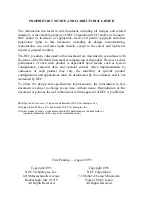
8
CONNECTING THE CHARGER TO THE BATTERY
1. Disconnect AC power supply before making or breaking DC / battery connections.
2.
If charging a battery in the vehicle with the battery clips, before making connections, first check that the battery clips can be safely and securely
positioned clear from surrounding wiring, metal tubing or the chassis. Make connections in the following order:
First connect to the battery terminal not connected to the chassis (normally positive),
then connect the other battery clip (normally negative) to the chassis well away from
the battery and fuel line. Always disconnect in reverse sequence.
3.
When charging a battery out of the vehicle with the battery clips, place it in a well ventilated area. Connect the charger to the battery: RED clamp
to POSITIVE (POS, P or +) terminal and BLACK clamp to NEGATIVE (NEG, N or –) terminal. Make sure the connections are firm and secure. Good
contact is important.
4. If the battery is deeply discharged, remove from the vehicle and inspect the battery before connecting the charger for a recovery
attempt.
Visually check the battery for mechanical defects such as a bulging or cracked casing, or signs of electrolyte leakage. If the battery has
filler caps and the plates within the cells can be seen from the outside, examine the battery carefully to try to determine
if any cells seem different to the others (for example, with white matter between the plates, plates touching). If mechanical defects are apparent do
not attempt to charge the battery, have the battery professionally assessed.
5.
If the battery is new
, before connecting the charger read the battery manufacturer’s safety and operational instructions carefully. If applicable,
carefully and exactly follow acid filling instructions.
USING THE OPTIMATE 1: PROCEEDING TO CHARGE
AC SUPPLY:
GLOBAL 100-240Vac 50-60Hz.
For safety reasons, the OptiMate output will only activate if a battery retaining at least 4V is connected.
VERY FLAT NEGLECTED BATTERIES:
Pay particularly close attention to the following which is especially important for
relatively small batteries such as those used on motorcycles, lawn tractors, jet-ski’s, snowmobiles and similar:
A battery left
deep-discharged for an extended period may develop permanent damage in one or more cells. Such batteries may heat up excessively
during high current charging.
Monitor the battery temperature during the first hour, then hourly there-after. Check for unusual signs, such as bubbling or leaking
electrolyte, heightened activity in one cell compared to others, or hissing sounds. If at any time the battery is uncomfortably hot to
touch or you notice any unusual signs, DISCONNECT THE CHARGER IMMEDIATELY.
ECO POWER SAVING MODE WHEN THE CHARGER IS CONNECTED TO AC SUPPLY:
The power converter switches to
ECO mode when the charger is not connected to a battery resulting in a very low power draw of less than 0.5W, equivalent to power
consumption of 0.012 kWh per day. When a battery is connected to the charger power consumption depends on the current demand
of the battery and its connected vehicle / electronic circuitry. After the battery has been charged and the charger is in long term
maintenance charge mode (to keep the battery at 100% charge) the total power consumption is estimated to be 0.060 kWh or less
per day.
LED #1 LED #2 LED #3
AUTOMATIC
MAINTENANCE
CHARGER
Содержание Optimate 1 Duo TM409
Страница 3: ...25 50 75 100 10 10 30 50 75 100 LiFePO4 AGM 25 50 75 100 10 STD VOLTS 3 ...
Страница 21: ...21 ...
Страница 23: ...23 2 361 3 858 1 517 1 655 0 681 144 TM409 ...









































